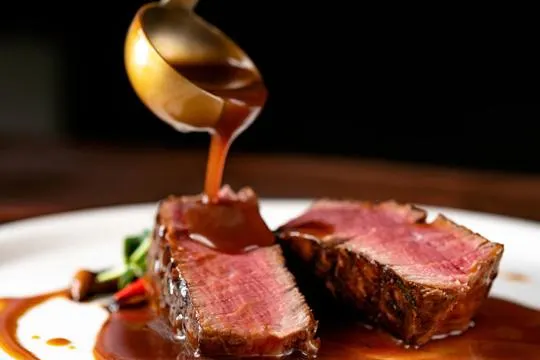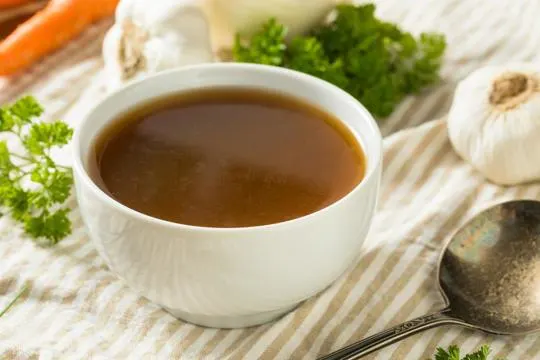Diving into the kitchen, we often hear folks mixing up demi-glace and stock.
Both are foundational in cooking, yet they couldn’t be more different. Ever wondered what sets them apart?
We’ve had our mix-ups. Like that time we tried to impress a date with our “famous” beef bourguignon. Spoiler: using stock instead of demi-glace didn’t earn us any chef hats.
Demi-glace is the rich, concentrated stuff of dreams; it’s like the sauce equivalent of turning lead into gold. Stock, on the other hand, is the backbone. It’s what you start with, not end.
We’ll break it down Barney-style. No kitchen jargon or fluff.
Just us, you, and the straight scoop on why knowing this difference can save your dinner.
What is Demi-Glace?

Demi-glace is no ordinary stock.
It’s a reduction made from combining brown stock and espagnole sauce.
This results in a super velvety texture and intense taste that takes dishes to the next level.
The process involves simmering the mix for hours.
This slow reduction helps bring out the natural flavors of the ingredients, creating a thick and glossy sauce that coats the food.
Demi-glace is very versatile.
It can be used as a base for sauces, such as bordelaise or mushroom sauce.
Or, simply drizzled over roasted meats as a flavor enhancer.
It doesn’t take much to transform a dish into something extraordinary.
This classic French sauce is super popular with modern chefs, too.
Its intense flavor adds depth and sophistication to contemporary dishes, making it a worldwide favorite.
What is Stock?

Stock is an essential and versatile ingredient in the culinary world.
It’s made by simmering animal bones, meat, veggies, and aromatic herbs in water for a long time.
This slow cooking process extracts the flavors and nutrients from the ingredients, making a flavorful liquid.
Stock not only serves as a base but it also adds complexity to sauces, soups, stews, and gravies.
Plus, the collagen released from the bones during cooking gives it a gelatinous texture when cooled.
This helps dishes achieve a silky mouthfeel.
Different types of stock can be created based on the ingredients used.
For example, veggie stock is made by simmering veggies like carrots, celery, onions, and herbs.
Chicken or poultry stock is made by boiling poultry bones or carcasses with mirepoix (a mix of diced onions, carrots, and celery).
Similarly, beef or veal stock requires simmering beef or veal bones with mirepoix.
Stock is often prepared in large batches and stored.
It can be refrigerated or frozen so it remains fresh until needed.
Chefs rely on stocks to build flavor in dishes, and enrich them with homemade liquids packed with nutrients.
Differences Between Demi-Glace and Stock

Demi-glace and stock may share some similarities, but they have differences in preparation, cooking time, thickness, flavor, and usage.
So keep this in mind when deciding which to use in your cooking.
Ingredients Used
Demi-glace and stock have unique flavors and textures due to their different ingredients.
Demi-glace usually includes meat like veal or beef, carrots, onions, and herbs like thyme and bay leaves.
Stock is created by simmering bones, celery, onions, and carrots.
The combination of ingredients gives each dish a different taste, making for an exciting culinary experience.
Preparation Method
When it comes to culinary delights, the preparation method matters.
To get the real taste and flavors of a dish, you must understand how to make it.
Here, we look into the interesting world of demi-glace and stock.
We focus on their distinct preparation methods.
Let’s begin our journey.
Demi-Glace:
o Collect high-quality beef or veal bones.
o Roast the bones in an oven until golden.
o Place the roasted bones in a stockpot with mirepoix, tomato paste, and herbs like thyme and bay leaves.
o Pour water over the ingredients, covering them.
Stock:
o Choose a base ingredient like chicken or vegetable.
o Cut onions, carrots, and celery into same-sized pieces.
o Combine the vegetables with parsley, peppercorns, and bay leaves in a pot.
o Pour water until it’s an inch above the ingredients.
Understanding Details:
Demi-glace has intense flavors from its extended cooking time.
It reduces to half its original volume during the simmering process.
Stock has a lighter flavor, great for use as a base in soups, sauces, or gravies.
Now that you know the preparation methods, you can make dishes with demi-glace and stock.
Cooking these dishes will bring you joy and satisfaction.
So go ahead and explore the world of demi-glace and stock.
Let your taste buds discover new flavors.
Flavor and Usage
Demi-glace and stock differ in flavor and usage.
Demi-glace is a velvety, concentrated sauce.
It has a savory, sweet flavor.
It is great for roasted meats, stews, and gravies.
It adds complexity to recipes.
Stock is liquid made from simmering bones, veggies, herbs, and spices.
It has a subtle, well-rounded flavor.
It can be used for soups, sauces, braises, risottos, and more.
It doesn’t overpower other ingredients.
Demi-glace takes longer to make.
It must be reduced until thick.
Stock is faster.
Simmer the ingredients for several hours.
In conclusion: demi-glace has an indulgent taste.
Stock is versatile and subtle.
Knowing the differences helps chefs pick the right option.
Texture and Consistency
Demi-glace & stock have different textures & consistencies.
Demi-glace is a glossy, thick sauce that coats foods evenly.
Stock has a lighter texture and thinner consistency.
Demi-glace adds an indulgent touch to dishes.
Its ingredients are slowly reduced, intensifying flavour and creating a silky mouthfeel.
It coats proteins like steak or roasted chicken, making meals luxurious.
Stock has subtle flavors and thin consistency, making it suitable for deglazing pans, poaching delicate ingredients, and sauces.
It elevates dishes in a distinct way, allowing their true essence to shine through.
Similarities Between Demi-Glace and Stock

Demi-glace and stock are both important in cooking.
They are both savory liquids made by simmering ingredients.
They both provide flavor and richness for sauces, soups, and stews.
Demi-glace is made by combining equal parts of brown sauce and brown stock, then reducing it further.
This creates a velvety texture.
Stock is made by simmering bones or vegetables in water for a long time, and then straining it.
It has a lighter flavor than demi-glace.
Demi-glace and stock have similar methods of preparation and culinary uses.
But they are different.
Understanding these differences helps chefs choose the right base for their dishes.
So, if you’re looking for intense flavor or a lighter foundation, both demi-glace and stock will help make your dishes delicious.
Culinary Applications of Demi-Glace and Stock
Demi-glace and stock are essential in the culinary world.
They have different uses that make them stand apart.
Demi-glace is a flavorful sauce.
It forms a base for velvety sauces and adds flavor to meats.
Stock is a liquid made from bones, vegetables, and herbs.
It provides a base for soups, stews, and sauces.
Demi-glace brings complexity to dishes.
Stock adds a well-rounded flavor.
Both play a major role in making dishes more delicious.
How to Make Demi-Glace and Stock?
To make demi-glace and stock, here’s how:
- Gather all the ingredients needed for both.
- To make demi-glace, simmer veal or beef bones with mirepoix in a pot.
- Let the flavors develop over time.
- Strain the liquid after several hours to remove solids.
- Reduce it until thick.
- For stock, repeat step 2 but without reducing.
- You may add red wine or tomato paste for extra flavor in demi-glace.
Stock is mainly used as a base for sauces and soups.
Both need patience and attention to get the desired flavors.
Conclusion
All in all, stock and demi-glace are both important building blocks in any culinary kitchen.
The differences between the two amounts to the amount of time it takes to make, the intensity of flavor, and whether there is an added element like flour or tomato.
Stock is a much more gentle liquid base that can be used for soups and stews while demi-glace adds an enhanced level of complexity to whatever dish its added to.
Understanding when to use each item is key for creating the perfect flavor profile when combining ingredients.
If you’re looking for lighter fare, stick with stock but if you’re wanting something with a little extra kick thrown in the mix, try demi-glace instead.
No matter what cooking task you undertake though, having some stock and demi-glace on hand is essential for any chef looking for a well versed foundation to their dishes.

Leave a comment